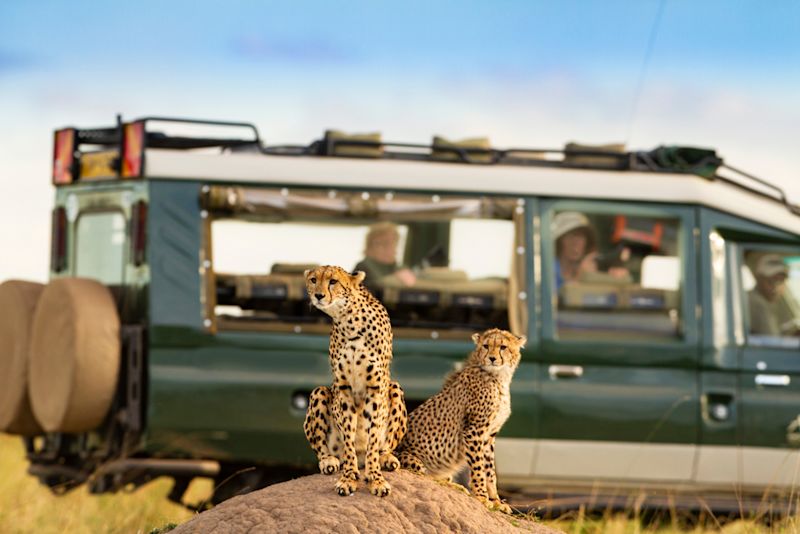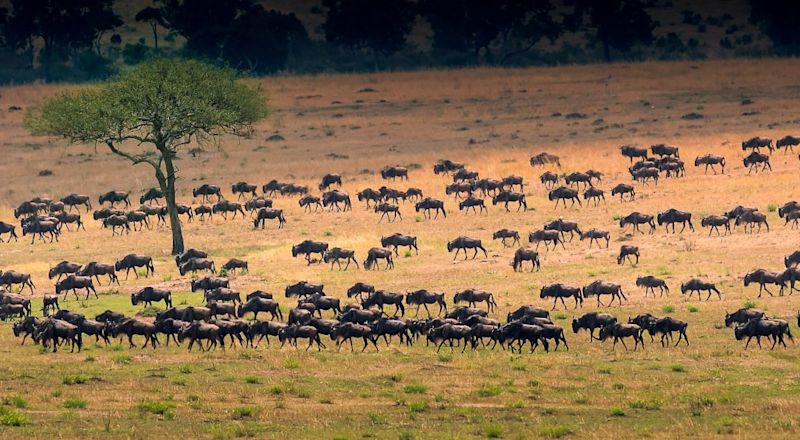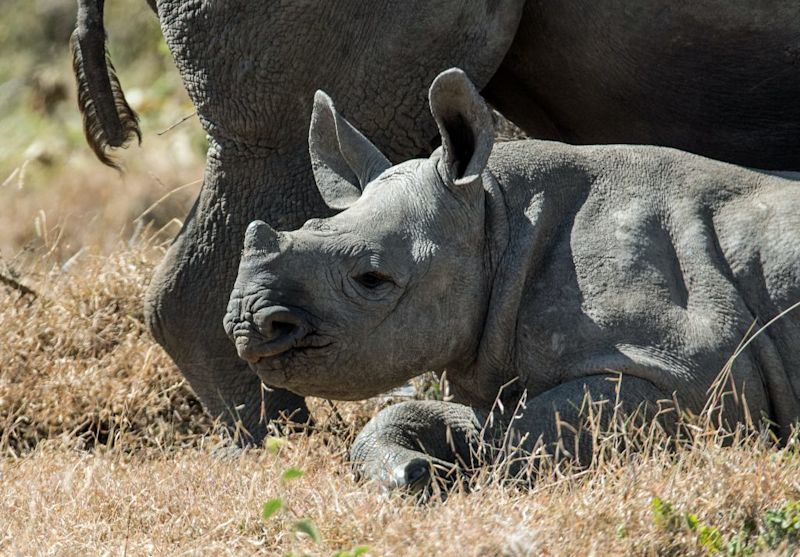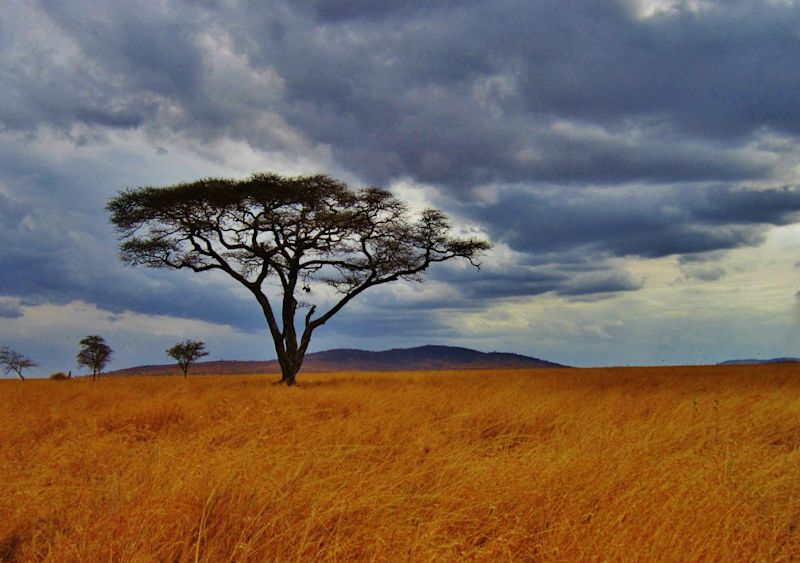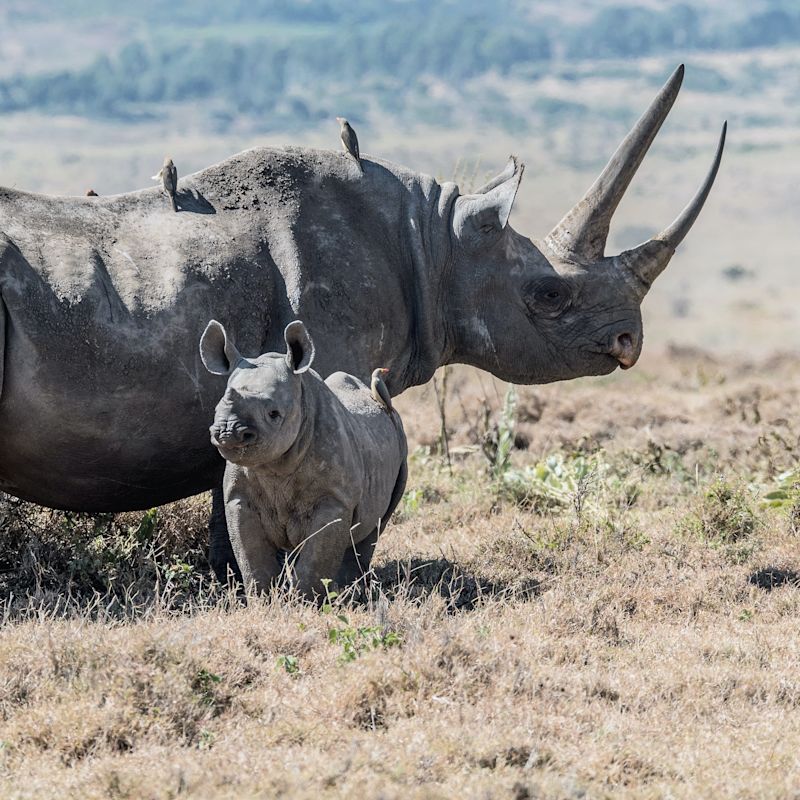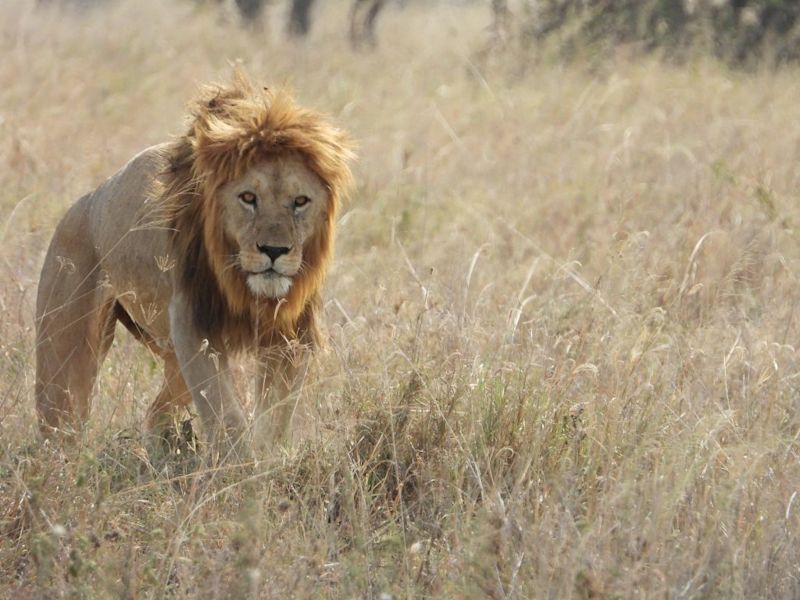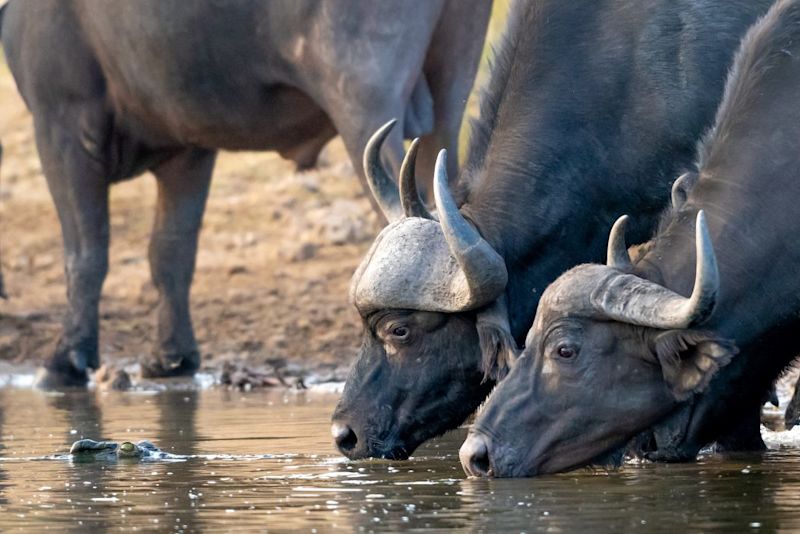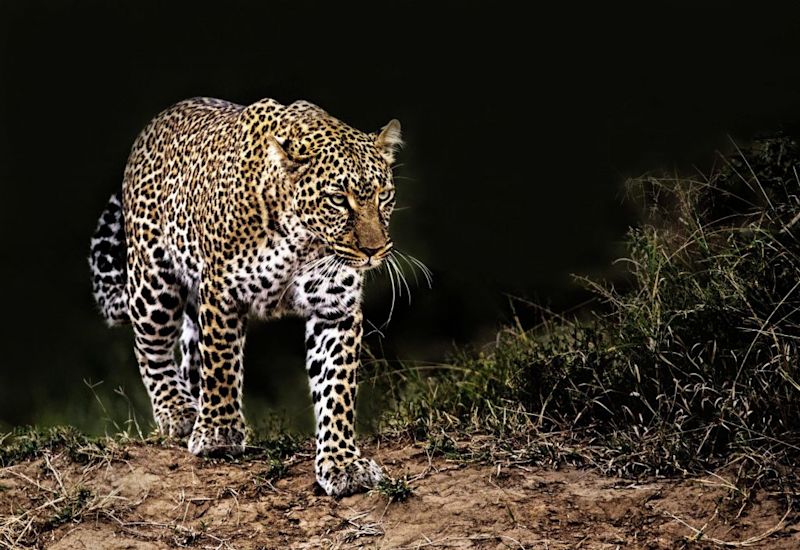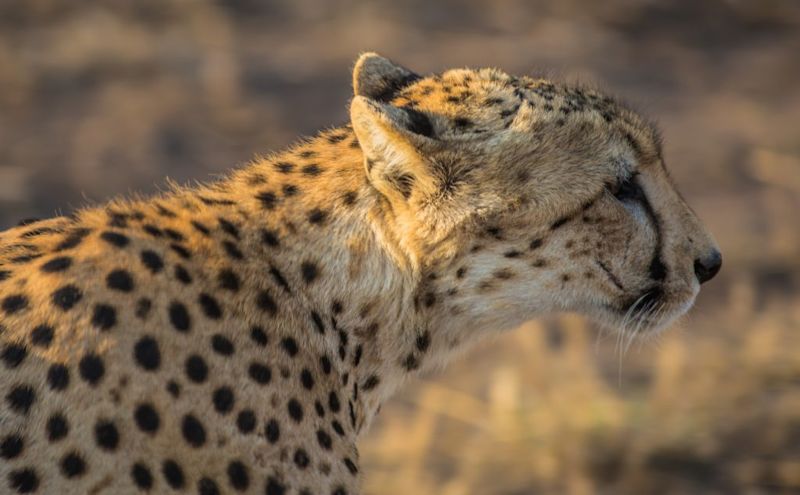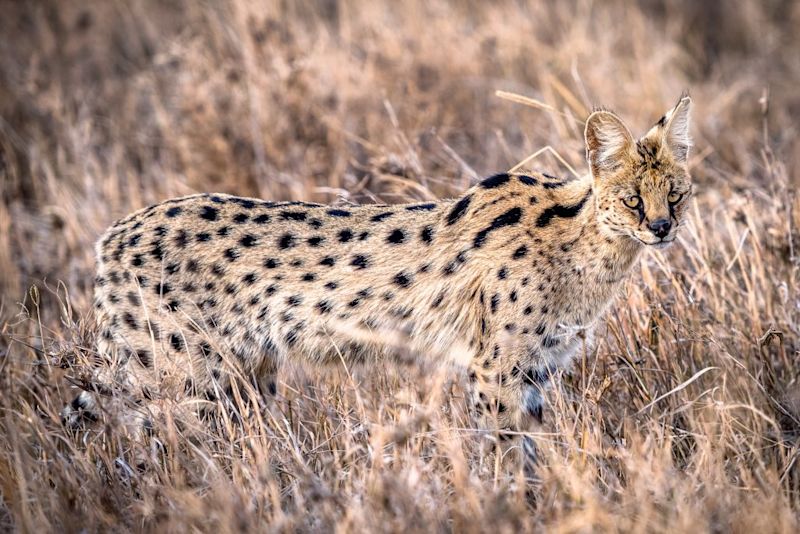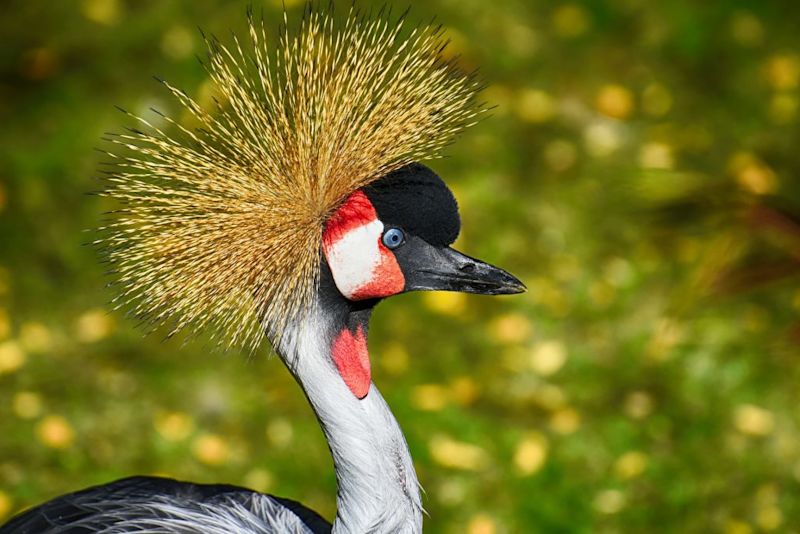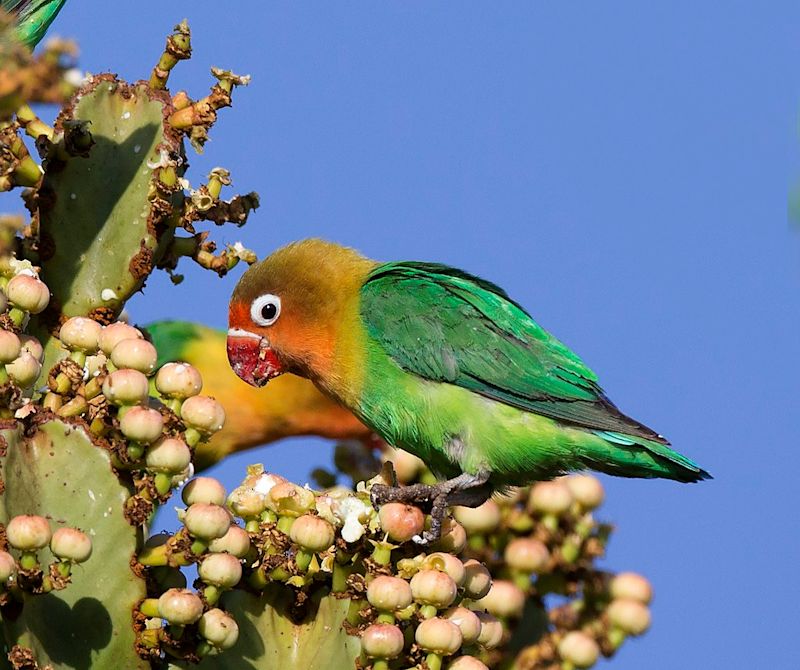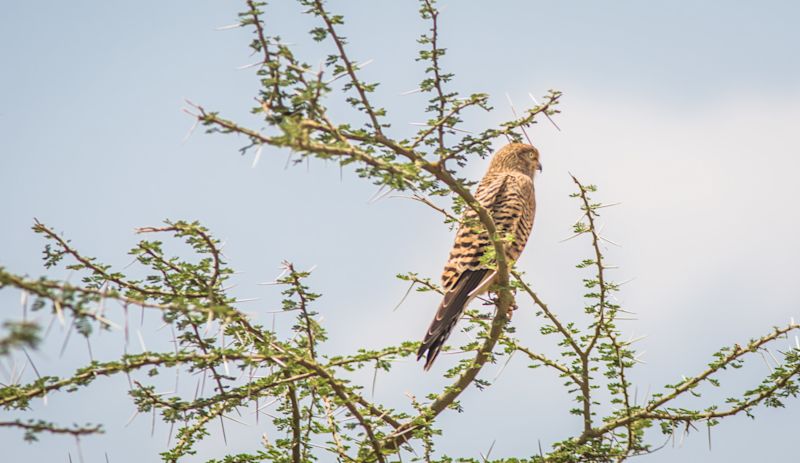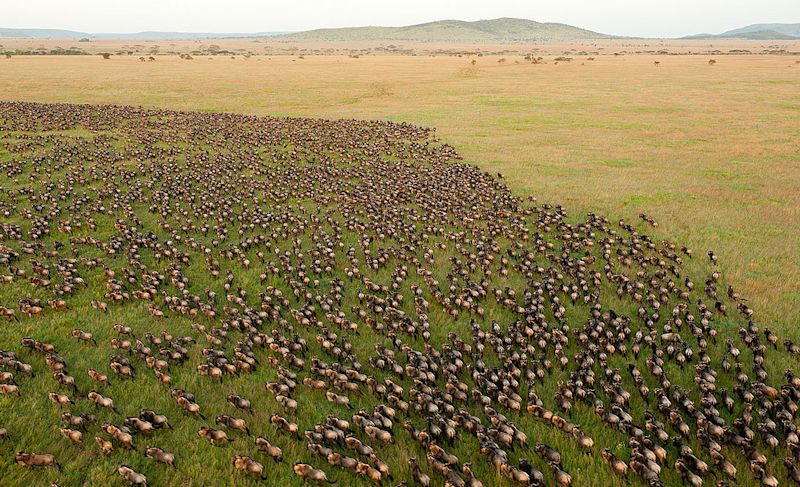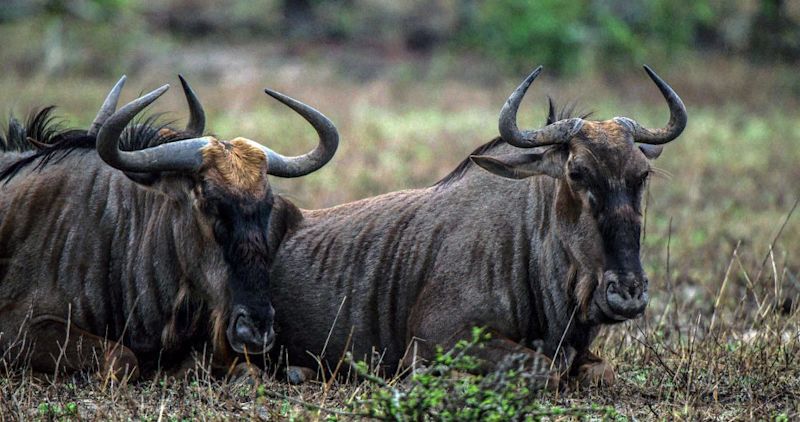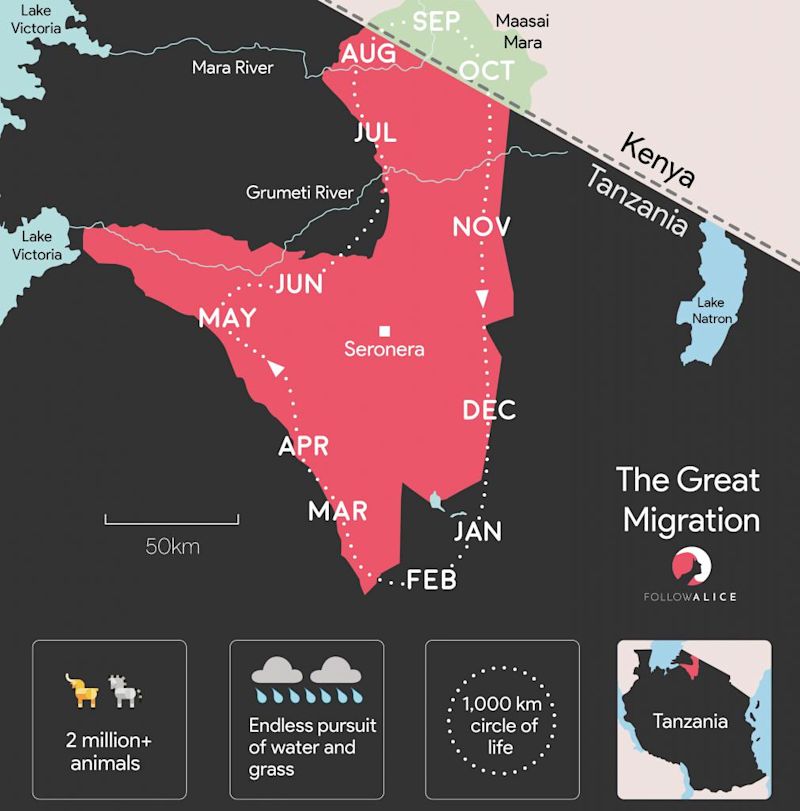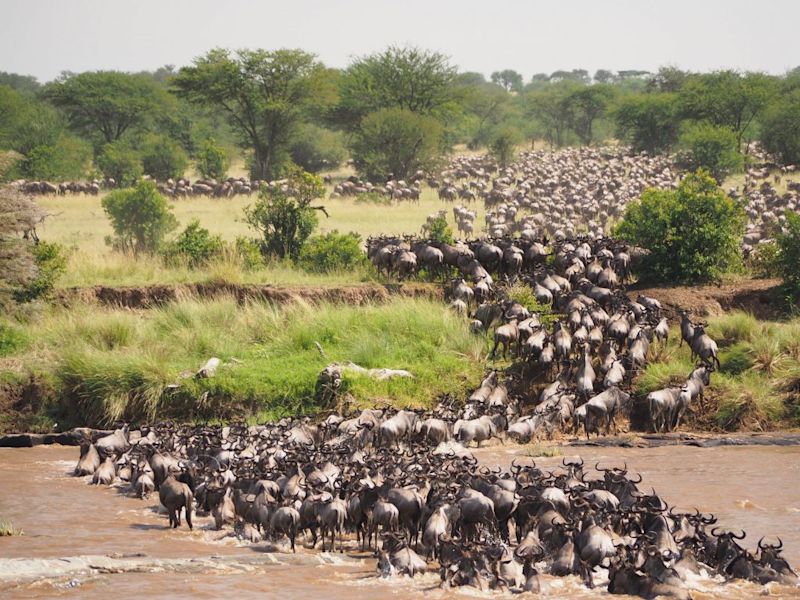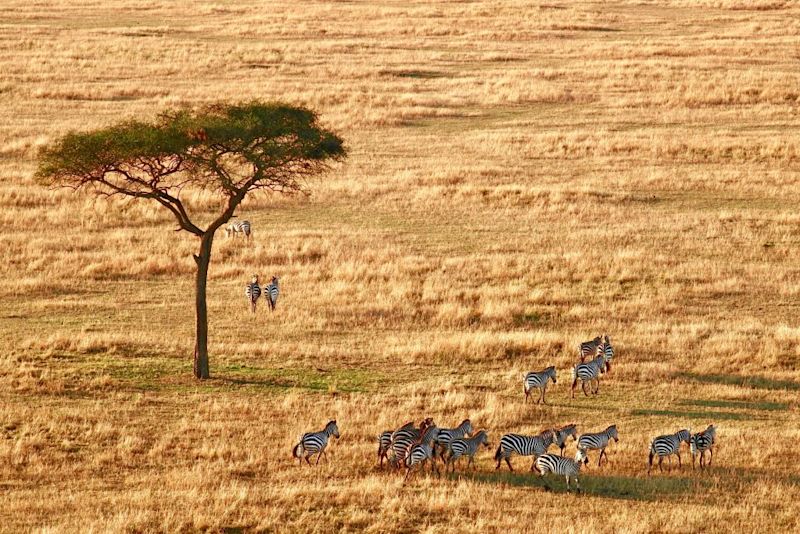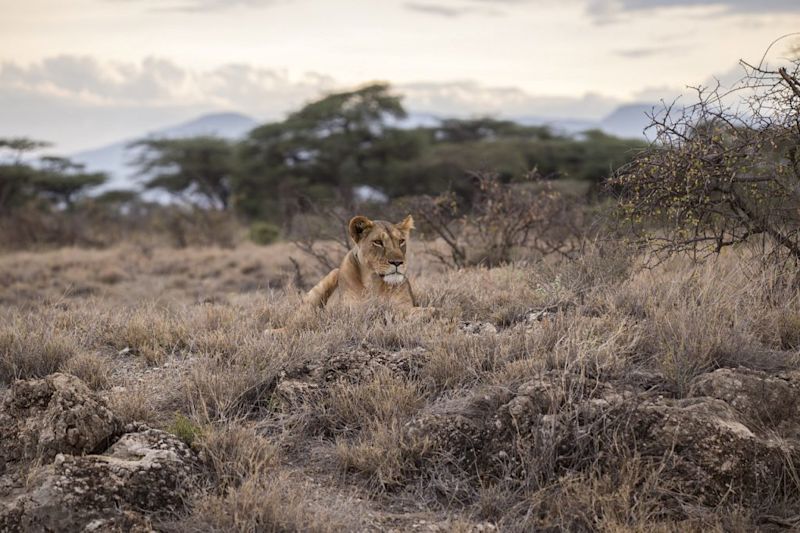So the Serengeti is world-famous because of its immense size as well as the presence of the Big Five and the Great Migration. In fact, these reasons, among others, make the Serengeti the ultimate safari destination! Seriously. We can't think of another park to match it.
A truly vast park
At nearly 15,000 km², Serengeti National Park is a truly vast park. For comparison, it's larger than the state of Maryland.
The sheer quantity and diversity of wildlife within the park's borders is mind-boggling. You can drive for hours in any direction and see hundreds of different species of animals and birds. And all living within their natural habitat, as it should be.
Learn more about the myriad creatures of the Serengeti below.
When male cheetahs group together to hunt, we call them a coalition of cheetahs
The Great Migration
Then there's the spectacle of the Great Migration herds spilling across the plains of the Serengeti. Over two million hoofed animals take part in this migration in a never-ending search for water and greener pasture.
At certain places along the migration path, the herds must rivers. There is utter pandemonium when this occurs! The animals sense the dangers, and plunge across en masse, moving as quickly as possible. Many are trampled to death, others are swept away the current, and still others are taken out by crocodiles.
Learn more about this show-stopping spectacle that is the Great Migration below.
Over a million wildebeests take part in the Great Migration – this is truly a sight you have to see for yourself to appreciate the scale
The Big Five
Importantly, you can find the Big Five in Serengeti National Park: lion, leopard, bush elephant, African buffalo and black rhino. There are actually very few parks in Africa where one can find all of the Big Five.
Furthermore, the groupings of each of the Big Five in the Serengeti are often massive, like buffalo herds that are sometimes thousands strong. There's even a 'super pride' of lions in central Serengeti that has 22 members!
There's more about the Big Five below, and we're confident plenty of it will actually surprise you!
Black rhinos are smaller, fiercer and more endangered than white rhinos
Beautiful landscapes
The Serengeti is a treat to visit not just for the animals, but also for its vast and varied spaces. The park encompasses woodlands, grasslands, wetlands, riverine forests and more. It’s a rich, varied and gorgeous ecosystem that you have to see and experience for yourself to fully appreciate.
For those who love landscape photography, please read Best time to visit Serengeti National Park to learn when to capture its heavy, stormy skies.
Acacia trees are synonymous with the Serengeti
We really cannot recommend enough that you make the time to visit Serengeti National Park. You won’t be disappointed!
More about the Big Five ...
Yes, you can find the Big Five in Serengeti National Park! That means you can look forward to hopefully spotting lion, leopard, rhino, buffalo and elephant.
You might be interested to know that the term Big Five wasn’t coined in relation to the size of the animals. A hippo, for instance, is far bigger and heavier than a lion or leopard, yet isn’t included in the Big Five.
Instead, the term was devised by game hunters in reference to the animals that are the hardest to kill on foot. This is because they're elusive, fast and ferocious. A rather sad, but true, etymology.
Fortunately, the animals within Serengeti National Park are protected, so there’s no hunting allowed there anymore.
A little about each of the Big Five animals found in the Serengeti ...
1. Eastern black rhinos
Rhinos are classified as being white or black, with the two species being easily distinguishable by the shapes of their mouths. Black rhinos have pointed or hook-lipped mouths, used to pick leaves off of trees and shrubs.
White rhinos, on the other hand, have wider, square-lipped mouths used for grazing grass. (White rhinos aren’t, of course, white in colour, and they actually have their name because English settlers to South Africa misinterpreted the Afrikaans word wyd, which means ‘wide’, to mean ‘white’.) The Serengeti is home to black rhinos, and they too aren’t the colour of their name: black rhinos are grey or brown.
Unfortunately rhino poaching is a serious problem wherever rhinos live in the wild. Things got so bad in Serengeti in the 70s, that by 1978 the entire black rhino population of the Serengeti-Mara ecosystem was believed to have been reduced to just 10 individuals.
Happily, that number is a little less scary at present, but the species is still critically endangered. Certain subspecies like the western black rhino have been declared extinct.
A black rhino sighting is extremely special
2. African lions
There are around 3,000 lions living in the Serengeti ecosystem. They’re relatively easy to spot not just because of their numbers, but also because they like to loll about for hours each day under trees. In fact, lions can lounge around for about 20 hours a day.
Being social creatures, lions live in prides. Related lionesses spend their entire lives together in a pride, along with up to three unrelated male lions. Lionesses do the hunting in groups while the male lions stay and protect the pride. But the males have first dibs when a kill is brought back the pride. And did you know that the male lion has the loudest roar of any cat species? It can be heard up to 8 km (5 miles) away!
Male lions tend to hunt alone, while lionesses hunt together
3. African bush elephants
Ever heard the saying that an elephant never forgets? This is because elephants have excellent memory. An African bush elephant’s brain can weigh up to 5 kg (11 lb), which is the heaviest of any land animal. And speaking of mass, can you believe that fully grown African elephant bulls regularly grow to be five to six tons?!
African elephants differ from Asian elephants in quite a few ways; there are differences, for instance, in terms of size, head shape, tusk, trunk tip, skin, and ear shape and size. And then African bush elephants differ from African forest elephants, the former being bigger and having a concave back to the latter’s almost flat back. Serengeti National Park has African bush elephants, which are the largest land mammals in the world.
Elephants roll in mud to cool down and protect themselves from the sun and insects bites
The Serengeti has the African bush elephant, a separate species from the African forest elephant, which is smaller and lives in Central and West Africa.
4. Cape buffaloes
Cape buffaloes (also known as African buffaloes) are large bovines that spend their lives in large herds. They’re fearsome creatures not to be trifled with. A herd of buffaloes will even take on a lion, especially if revenge is needed for a nabbed calf.
A buffalo can weigh up to a ton. The males have thick, rounded horns that are powerful weapons. Their only real predators aside from humans are lions and large crocodiles. But a buffalo is not an easy kill, and they’re incredibly ferocious when cornered. They're generally considered one of the most dangerous of Africa's animals.
Cape buffaloes having a drink
5. African leopards
Leopards are notoriously hard to spot, as they’re solitary creatures and also like to sit camouflaged in trees. The best way to find a leopard is with an experienced driver-guide.
In the Serengeti, leopards often hang out in the trees lining the Seronera River.
When a leopard has a kill, it usually drags it up into the tree so that scavengers like hyenas won’t hassle them. They have incredibly powerful jaws.
Like domestic cats, leopards growl when angry and purr when content. They’ll also scratch trees, urinate and defecate to mark their territory and warn off other leopards.
Male and female leopards come together only to mate, then head back off on their own missions. When a leopardess gives birth (usually to two or three cubs at a time), she does however look after them for about two years. After that, the youngsters strike out on their own.
That fearsome gaze ...
Other animals of the Serengeti
Serengeti National Park is home to over 300 animal species. And the populations of many are very healthy and strong. Some of the exciting animals beyond the Big Five to look for on safari are:
- Aardvark
- Aardwolf (civet hyena)
- Baboon
- Bat-eared fox
- Cheetah
- Crocodile
- Eland
- Gazelle
- Giraffe
- Guereza (colobus monkey)
- Hippo
- Hyena
- Impala
- Kongoni (hartebeest)
- Mongoose
- Porcupine
- Serval
- Topi
- Wild dog (painted dog)
- Wildebeest (gnu)
- Zebra
Close up of a beautiful cheetah in Serengeti National Park
Cheetahs can usually be found on the southeastern plains of Serengeti. They hunt the park’s gazelles. A cheetah find is really something to write home about, as their numbers are low. There are only about 300 cheetahs in the entire Serengeti-Mara ecosystem.
It’s very rare to see a wild dog in Serengeti, but they are there. Again, your best chance of finding one is with a well-trained safari guide.
The Retina Hippo Pool in central Serengeti is a great place to see plenty of hippos, as well as some crocs.
The website of Serengeti National Park has a list of its animals for those of you who are interested.
Serval cats have large ears as they use their hearing to locate prey
Birds of Serengeti National Park
Serengeti National Park has an extremely impressive population of resident and migratory birds. In fact, it can claim over 500 bird species!
One beauty of the Serengeti is the grey crowned crane, which is easy to spot for its spray of stiff gold head feathers.
A grey crowned crane
Another of the gems to be on the lookout is the Kori bustard, which seldom flies and can often be seen with smaller birds perching on its back.
One very pretty bird to keep your eyes peeled for is the Fischer’s lovebird, a songbird that has beautifully vibrant orange, green and yellow plumage. It's lives in the wild in Tanzania alone. It can be found in the wooded areas of Serengeti.
A Fischers lovebird in Serengeti
Also endemic to Tanzania and also very pretty is the rufous-tailed weaver, a small songbird that is in a genus of its own.
Also keep your eyes open for the beautifully patterned greater kestrel, a member of the falcon family.
Other special and striking birds to look for in Serengeti include:
- African ostrich
- Augur buzzard
- Black-headed heron
- Black kite
- Golden-winged sunbird
- Greater blue-eared starling
- Grey-breasted spurfowl
- Reichenow's seedeater
- Scarlet-chested sunbird
- Secretary bird
- Usambiro barbet
- White-bellied bustard
Serengeti National Park has a list of bird species for those of you interested in learning more about the birds you might spot there.
A greater kestrel resting on a mega-thorny acacia tree
More about the Great Migration ...
The Great Migration, also known as the Great Wildebeest Migration and the Great Wildlife Migration, is the largest land-based mammal migration in the world. It’s an annual mass migration that sees enormous antelope herds move north and northeast through Tanzania towards the lands of Maasai Mara Game Reserve in the very south of Kenya. While the animals actually migrate within the Serengeti-Mara ecosystem throughout the year, the Great Migration refers to the period when the herds head north to find water and greener pastures because the dry season has set in.
The scale of the Great Migration is like nothing else on earth
The driving force behind the migration is the search for grazing pasture and water. While the course of the migration naturally changes a little each year based on factors like rainfall and land changes, the overall path of the migration is fairly predictable. This allows guides and visitors to the park to know whereabouts to head to see the migration in action.
At the very heart of the Great Migration is the wildebeest, or gnu. (The name wildebeest is Afrikaans for ‘wild beast’.) Roughly one and a half million wildebeest take part in the migration, as well as 300,000 Thomson’s gazelles, 200,000 zebras, as well as large herds of elands and impalas.
Two resting wildebeests, also known as gnus
Interestingly, one of the reasons why wildebeest and zebra are able to exist in harmony and migrate together is that they eat different parts of the same grass.
The scale of the Great Migration is topped only by Zambia’s Kasanka Bat Migration. But the former is more famous as the open plains and size of the antelopes makes for such an incredibly popcorn-munching spectacle.
Serengeti Migration map
Here's a map showing the general movement of the animals of the Great Migration.
Map of the Great Wildlife Migration
If you're keen to see the Great Migration (and who isn't?) and want to know when to visit the Serengeti to see it, we're going to direct you once again to Best time to visit Serengeti National Park.
Great Migration river crossings
Some of the most mesmerising moments of every migration are the Mara and Grumeti River crossings within Serengeti National Park. There is pandemonium whenever a herd of wildebeests crosses one of the rivers. They sense the danger, but are so powerfully driven by instinct to reach good pasture. Every year thousands of wildebeest don’t survive the river crossings, succumbing to the stampede or crocodile attacks. Their carcasses then form a vital part of the ecosystem, feeding crocs, hippos, hyenas, vultures, fish and more.
Did you know that wildebeests possess a ‘swarm intelligence’, which allows them to approach and overcome obstacles as one?
Wildebeests plunge across the Mara River, desperate to escape its dangers
The Serengeti-Mara ecosystem
The Serengeti-Mara ecosystem is a cross-border, protected region that includes the Maasai Mara National Reserve in Kenya and the Serengeti National Park and Ngorongoro Conservation Area in Tanzania. At 40,000 square kilometres (over 15,000 square miles), it’s one of the largest ecosystems in the world!
Every year about half a million wildebeest are born into the ecosystem. Calving season is January to March, which is why this is one of the peak seasons in Serengeti National Park. In February around 8,000 calves are born every day! Zebra and other buck are also born at this time, so visitors get to witness calves being born left, right and centre.
A balloon safari offers a unique perspective of the Serengeti and its wildlife
Great Migration predators
The migration draws plenty of predators too, like lions and crocodiles, adding to the drama and spectacle. In fact, the lions of Serengeti spend the migration months following the movements of the wildebeest migration.
Scavengers like hyenas are also an important part of the ecosystem, as they feed on the carcasses of the wildebeest and other animals that don't survive the migration.
A lioness blends in with the dry vegetation
Need we say more?
So now you know what the Serengeti is famous for, when will you be booking your trip there?? If you'd like to chat with someone to learn more, please feel free to hit us up. Or for more safari photos, check us out on Instagram.


